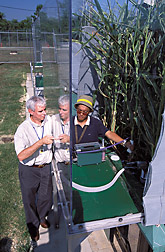Oct
15
A Look At the Research For Biomass Production
October 15, 2008 | 2 Comments
The USDA’s Agricultural Research Service’s (ARS) national program on Agricultural System Competitiveness and Sustainability scientists are combining economic and natural-resources analyses with data drawn from a national network of field experiments that are being used in models developed by ARS and the USDA Economic Research Service. The research is making it easier to understand the consequences of individual and combined management decisions and to predict the most sustainable, economic, and environmentally beneficial courses of agricultural activity.
The search for alternative fuels has absorbed increasing amounts of agricultural resources, raising questions about how biofuel production affects U.S. agriculture and consumers. The USDA with decades of experience in farm support programs understands, at least from a bureaucratic point of view that trade-offs exist between production and sustaining the land and farmers. Using crops whether for food or fuel have environmental impacts on the soils and downstream ecosystems. The farm operators need profitability to participate in the economy. Those are the main factors with literally hundreds or thousands of localized factors to consider.
ARS scientists are combining economic and natural-resources analyses with data drawn from a national network of field experiments that are being used in models developed by ARS and the USDA Economic Research Service (ERS). Their research is making it easier to understand the consequences of individual and combined management decisions and to predict the most sustainable, economic, and environmentally beneficial courses of action.
At the top of the list is the crop residue materials left over from crops. At more than 1 billion tons, it’s a huge resource. But the residue returns much nutrient material and provides cover and erosion control to the soils. By no means can 1 billion tons be accessed without serious long-term negative effects.
ARS scientists at 22 locations are examining the sustainability of various production strategies, including growing different energy crops and using crop residues as feedstocks for bioenergy production. They’re using WholeFarm, a model originally designed by ARS scientists to assess crop rotations, commodity prices, yields, and profits. The scientists are updating WholeFarm so that it can gauge the feasibility of using regional crops and residues as sustainable feedstocks that complement existing food, feed, and fiber production systems.
Models also help farmers decide which crops are the best to raise for food or bioenergy fuel feedstocks under their local conditions. Growing an unfamiliar crop can be a risky – and costly when it’s a mistake – decision. But as the demand for biofuels grows, so do incentives to grow bioenergy crops.
ARS scientists in Texas and Oregon are pairing two ARS biophysical models to evaluate the environmental impact of land-management practices on large, complex watersheds over time. The assessments will also take into account the effects of varying soils, land use, and management conditions.
Called the CQESTR model, it simulates changes in soil organic carbon based on factors such as climate, tillage management, crop rotation, and crop residue removal. By incorporating the model into the Soil and Water Assessment Tool—also known as SWAT scientists can predict how land-management practices will influence soil organic carbon, soil organic matter, water, sediment, and agricultural-chemical accumulation.
In another project, researchers at ARS’s Hydrology and Remote Sensing Laboratory in Beltsville, Maryland, are studying how certain crops sequester carbon in the soil, which recovers airborne carbon and limits its release into the air. The simulations assess the long-term effects of practices such as soil tillage and crop-residue management on soil erosion, soil quality, and yield. Inclusion of economic model results along with estimates from biophysical models will help the scientists forecast the effects of biofuel-feedstock production and harvest at farm, watershed, or regional scales. Profitability is an important consideration, just as factors like water quality and production efficiency are also significant.
Another of the ARS models called PGA-BIOECON, calculates the trade-offs among the three main objectives, allowing stakeholders to select the best management decisions to achieve their objectives. If a farm operator valued farm profit more than water quality, that operator would choose differently than one who valued water quality above all else—but the model would offer the best trade-off for either preference. The PGA-BIOECON simply provides the best scientific and economic information about those trade-offs, so an operator can make the best-informed choice.
The research is part of an interagency effort – with ERS, the U.S. Environmental Protection Agency, the U.S. Department of Energy, and USDA’s Natural Resources Conservation Service—to coordinate a multiscale assessment of the economic impact of feedstock production for sustainably producing biofuels.
From the collaboration with other federal agencies, ARS can broaden the scope of research learning how different production options influence not just the field, the farm, and the watershed, but entire regions and the nation as a whole.
Drawing on USDA National Agricultural Statistics Service data from the Agricultural Resource Management Survey and ARS’s EPIC, SWAT, and PGA-BIOECON results from field and watershed research, the ERS REAP model can project regional crop acreage, management practices used, and environmental consequences from agricultural activity.
This collaborative research between ARS and ERS is helping their scientists find the best ways to measure the effects of producing and harvesting biofuel feedstocks. This should help farmers, biofuel refiners, and regulatory and action agencies determine how best to serve the interests of the nation as we pursue ways to reduce our need for petroleum.
From the time of Abraham Lincoln and the founding of the land grant universities, on to the universities, the USDA and the agricultural states offering of the extension service bringing education, information and technology to agriculture the U.S. has enjoyed cheap food and fiber allowing the development of large urban areas and much wider diversification of people’s interests, careers and business opportunities. Without cheap food, available nearly ready to eat in hundreds of thousands of locations nationwide, most of what makes modern life possible simply wouldn’t exist.
For those familiar with the history of food in the U.S and how it has lead the world, the news of the USDA and the cooperating agencies getting up to speed in biofuels is a warming thought. Few Federal programs, perhaps none, have had such a subtle but dramatic impact on modern life. If the attitude and effort, the commitment and careful research that made modern food production so incredibly successful be applied with the verve, intensity, and integrity history has shown these agencies can provide, biofuels have a great future.
Comments
2 Comments so far




[…] … provisions in respect of agriculture and fisheries, food security, primary commodities and traditional agriculture, manufactures, services development and diversification, infrastructure, transfer of technology, and energy. In respect of social sector development, including policies and actions relating … A Look At the Research For Biomass Production […]
ISO 13485 Implementation…
Most companies that have implemented ISO 9001 or similar systems report significant improvements in productivity due to an increase in customer satisfaction and reduction in field returns and internal failures.